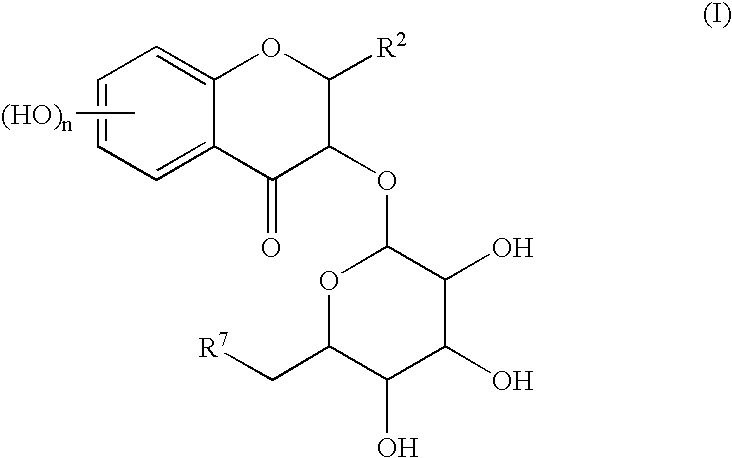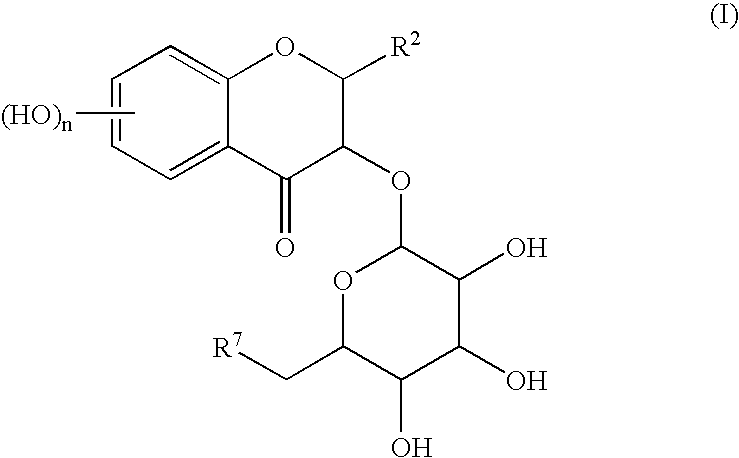Process for preparing flavonoids
a technology of flavonoids and flavonoids, which is applied in the field of preparation of flavonoids, can solve the problems of undetermined chemical total synthesis of astilbin, difficulty in using the compound isolated from plant matter as a medicine, and insufficient isolating procedure of plant matter, etc., and achieves good yield.
- Summary
- Abstract
- Description
- Claims
- Application Information
AI Technical Summary
Benefits of technology
Problems solved by technology
Method used
Image
Examples
example 1
##STR14##
To a mixture solution of 83.0 mg (0.218 mmol) of Cp.sub.2 HfCl.sub.2 and 90.8 mg (0.439 mmol) of AgClO.sub.4 in methylene chloride in the presence of 214 mg of pulverized and dried desiccant (molecular sieve 4A) were sequential added a solution of 127 mg (0.195 mmol) of Compound (1) in methylene chloride (3.0 ml) and a solution of 93.7 mg (0.197 mmol) of Compound (2) in methylene chloride (3.0 ml) at -78.degree. C. Then, the temperature of the reaction mixture was gradually increased up to -35.degree. C. during 1 hour, and the reaction mixture was stirred for 1 hour at the same temperature. After the reaction, saturated sodium hydrogen carbonate aqueous solution (2.0 ml) was added dropwise to the reaction mixture, and insoluble materials were removed off by Celite.RTM. filtration. Water was added to the obtained filtrate, and the mixture was extracted with ethyl acetate (thrice). The combined organic layer was washed with brine and dried over with anhydrous sodium sulfate. ...
example 2
##STR15##
A mixture solution of 87.4 mg (0.134 mmol) of Compound (1) and 64.3 mg (0.135 mmol) of Compound (2) in methylene chloride (4.0 ml) in the presence of 204 mg of pulverized and dried desiccant (molecular sieve 4A) was cooled to -78.degree. C. To this mixture was added a solution of t-Bu.sub.2 Si(OTf).sub.2 in methylne chloride (0.48 ml: 0.15 mmol), then, the temperature of the reaction mixture was gradually increased up to -20.degree. C. during 3 hours, and the reaction mixture was stirred for 50 minutes at the same temperature. After the reaction, aqueous saturated sodium hydrogen carbonate solution (2.0 ml) was added dropwise to the reaction mixture, and insoluble materials were removed off by Celite.RTM. filtration. Water was added to the obtained filtrate, and the mixture was extracted with ethyl acetate (thrice). The combined organic layer was washed with brine and dried over anhydrous sodium sulfate. The solvent was removed off under reduced pressure, and the resultant ...
example 3
The Compound (3) was obtained by repeating the same reaction described in the Example 2, by replacing the reaction solvent and the reaction reagent as indicated in the following table.
The yields were summarized in the following table.
PUM
| Property | Measurement | Unit |
|---|---|---|
| temperature | aaaaa | aaaaa |
| temperature | aaaaa | aaaaa |
| temperature | aaaaa | aaaaa |
Abstract
Description
Claims
Application Information
 Login to View More
Login to View More - R&D
- Intellectual Property
- Life Sciences
- Materials
- Tech Scout
- Unparalleled Data Quality
- Higher Quality Content
- 60% Fewer Hallucinations
Browse by: Latest US Patents, China's latest patents, Technical Efficacy Thesaurus, Application Domain, Technology Topic, Popular Technical Reports.
© 2025 PatSnap. All rights reserved.Legal|Privacy policy|Modern Slavery Act Transparency Statement|Sitemap|About US| Contact US: help@patsnap.com



